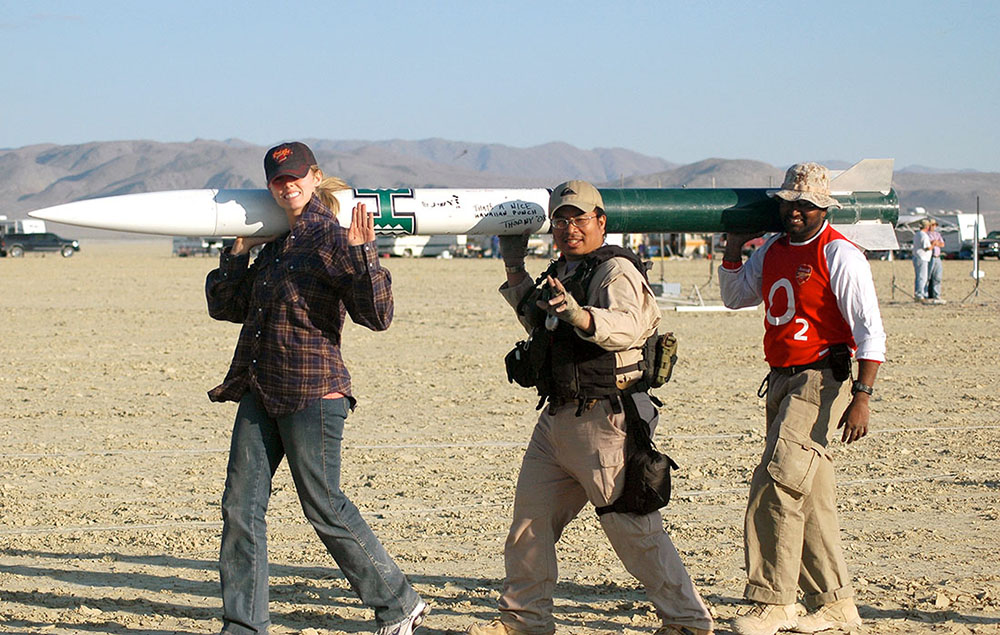High-Power Rocketry at Windward Community College
Jacob Hudson, Jr.
Na Huakai’i Newsletter Vol. 11
Under HSGC’s support and as the lead campus for Project Imua, Windward Community College’s Center for Aerospace Education (CAE) is continuing to expand its efforts in high- power rocketry and small payload development. According to the National Association of Rocketry (NAR), high-power rockets use motors loaded with over 125 grams of propellant that provide a total impulse exceeding 160 newton-seconds (“H” motor or higher) with an average thrust of at least 80 newtons. Rockets using hybrid motors, fabricated with ductile metal airframes or weighing more than 1500 grams (53 ounces) are also included in this category.
This year, WCC students are collaborating with those at Honolulu Community College on a re- engineered quadcopter that will be flown at September’s international rocketry competition at Black Rock, Nevada. This will mark WCC’s thirteenth consecutive entry at ARLISS (A Rocket Launch for International Student Satellites).
Hosted by AeroPAC (the local chapter of the Tripoli Rocketry Association), this annual event tasks engineering students to design, build, test, and ultimately fly a package that emulates a planetary atmospheric probe. The payloads are peer tested against each other by being launched via high-power rockets to high altitude. At apogee, the deployed payload must autonomously maneuver its way to a pre-determined location on the playa about 1.5 miles away, while simultaneously taking atmospheric data. The payload may broadcast its acquired data to a ground station, but may not receive any commands.
For ARLISS 2018, WCC has assembled a foldable quadcopter under the control of GPS-assisted software that will guide the fly-back payload to the pre-designated target. HCC has designed and built the Atmospheric Sampling Experiment Package (ASEP). With a total mass of less than 1 kg, these two integrated components are mounted in the rocket’s payload section—a cylinder 10.5 cm long and 5.8 cm in diameter.
As with its twelve previous entries, WCC’s participation in ARLISS 2018 is unique among the other competitors. WCC is the only institution that supplies its own custom-built rocket to launch its payload. The other colleges use rockets provided by AeroPAC members. The ARLISS competition requires each payload-carrying rocket to undergo rigorous inspection. All rockets must be certified to withstand the 5-g stress of launch and capable of safely carrying and deploying the payload to the specified altitude. As such, the rockets are designed with separate, but redundant chute deployments.
WCC’s rocket, named Ho‘ōla—which was rebuilt and brought back to life from the wreckage of a previous flight—has a pad weight of 50 lbs and is powered with an M1419 motor, with thrust sufficient to attain a maximum altitude of approximately 12,000 feet. This rocket has dual avionics (PerfectFlite StratologgerCF and Featherweight Raven altimeters) and a Rouse-Tech gas ejection system. At apogee the rocket separates into a booster and a forward payload section, both descending on individual chutes. Six seconds after apogee, the payload carrier is deployed, and the quadcopter is released and autonomously powered up.
While most of the participating teams employ ground traversing technology to steer their payload to the target, WCC’s strategy relies on a fly-back approach, which originally used a steerable parasail, and has now been upgraded to a quadcopter. A fly-back’s main obstacle is the desert’s head wind, which can blow the payload as much as 17 miles off course.
At this year’s ARLISS activities, WCC will also conduct two test launches of a second rocket that is being designed for the 2019 Student Launch Initiative (SLP—formerly USLI). SLP requires students to design and build both a scientific payload to gather data or perform an experiment and a rocket to lift that payload to a height of precisely one mile (no higher or lower). The first test flight (with drag shoes not deployed) will check for flight stability, on-board avionics, and determine the tared altitude (AGL). The second test flight will have the shoes deployed to 30 degrees and estimate the percent altitude loss. Both test flights will use a K1050 motor. The video of these test launches will be submitted with a joint WCC-HCC proposal for entry into SLP’s competitive selection process. This effort would constitute Project Imua’s Mission 6.
While at ARLISS, WCC students will also work towards their next rocket level certification. Damien Apilando (currently Level 2) is planning two flights for his Level 3—one with a K550 motor to test his avionics and the second with an M1419. L3 certification requires that flier to have at least one year of L2 experience and receive Technical Advisory Panel (TAP) approval for the rocket’s design. The L3 candidate must also submit a Data Capture packet to the TAP prior to its construction. The rocket must be scratch-built (no kits), have fiberglassed fins and nosecone, dual avionics, must have a dual deployed recovery system (drogue at apogee; main chute at some pre-set altitude), and powered by an M or higher motor.
Dylan Boeman (currently L1) is preparing for his written test and to fly an S4 rocket for his Level 2 certification. Julian Earle and Katherine Bronston are each building a rocket with H or I motor to qualify for Level 1. To count as a successful flight, the rocket must perform as expected and, after recovery, aside from normal wear and tear, the rocket should be re-launchable with a change of motor.
In support of WCC’s high-power rocketry endeavors, WCC has also established the Center for Aerospace Education Launch for University Students (CAELUS), which is a Section under the National Association of Rocketry. The goals of CAELUS are to support NAR activities on O‘ahu, operate and maintain a rocket range on the WCC campus in accordance with the NAR standards and Safety Code, and promote rocketry throughout Hawai‘i.


